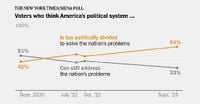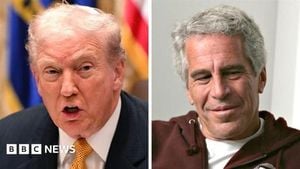Americans’ faith in the country’s ability to overcome political divisions has reached a new low, according to a flurry of recent polls and interviews that paint a sobering picture of the national mood in the fall of 2025. The latest survey, released October 2 by The New York Times and Siena University, found that just 33 percent of registered voters believe the United States can still solve its political problems—a dramatic drop from the 51 percent who felt that way in September 2020, even as the nation was mired in the COVID-19 pandemic.
It’s a shift that’s hard to ignore. Back then, Americans were arguing over masks and lockdowns, but most still clung to the idea that the country could unite to address its challenges. Now, five years later, the mood is far more pessimistic. The poll, conducted between September 22 and 27, 2025, with 1,313 registered voters, revealed that 64 percent of Americans think the country is too divided to solve its problems. That’s a significant jump from 42 percent in 2020, as reported by The New York Times.
This sense of gloom isn’t just about the numbers. It’s visible in the way Americans talk about politics and each other. Amber Yang, a 37-year-old Boston resident, summed up the frustration in an interview with The New York Times: “It is impossible now to have a policy discussion. There’s no consensus on the facts. And when you can’t have a conversation, how do you even move forward?”
So what’s driving this deepening cynicism? The poll suggests that Americans are increasingly worried about polarization and the very state of democracy—issues that now outrank old standbys like immigration, inflation, and crime. In fact, 13 percent of those surveyed now say political polarization is a serious problem, up from just 7 percent five years ago. Likewise, 9 percent now point to the state of democracy as a top concern, also up from 7 percent, according to The New York Times and Siena University data. The economy, while still a leading issue, was cited by only 16 percent—down from 20 percent in December 2023.
Recent events have only fueled this anxiety. The poll was conducted just weeks after the high-profile assassination of conservative activist Charlie Kirk at a Utah university, an act that shocked the nation and was quickly politicized. President Donald Trump and his allies seized on the tragedy, declaring war on “the left” and stoking already simmering tensions. This came on the heels of other violent incidents in 2025, including an arson attack on Pennsylvania Governor Josh Shapiro’s residence, the murder of a Democratic state lawmaker in Virginia, and the shooting of a UnitedHealthcare executive. The violence isn’t just a backdrop—it’s become a central part of the story, with many Americans now openly questioning whether the country can avoid further bloodshed.
Indeed, the specter of political violence is no longer hypothetical. In an April 2024 PBS NewsHour/NPR/Marist poll, 20 percent of U.S. adults believed violence might be necessary to fix the country. By 2025, that number had jumped to 30 percent, as reported by NPR. The attempted assassination of Trump himself at a Pennsylvania rally in July 2024, where a bullet grazed his ear, only heightened these fears.
Amid such turmoil, some have begun to wonder whether the United States could be heading for a breakup. On October 2, 2025, an article highlighted the growing interest in secession, citing an Axios poll that found 20 percent of Americans now support the idea of a “national divorce.” Secessionist movements, from Red-State groups to the California Independence Party and Texas Nationalists, point to unstoppable polarization as justification for their cause. Their main argument? That the two sides have irreconcilable differences and that the American system simply can’t be fixed.
But experts warn that secession is no panacea. Professor Ryan Griffiths, who has studied secessionist movements globally, told The Conversation that while polarization is indeed a serious and growing problem, “secession is the wrong solution.” He points to historical and international examples: “Most secessionist movements fail. Roughly half end in violence, and secessionism is one of the chief causes of war in the international system.” He notes that successful peaceful secessions, like the Velvet Divorce between Czechia and Slovakia, require conditions—such as a clearly defined nation with its own borders and administrative status—that simply don’t exist in the U.S.
Legally, the path is even rockier. The 1869 Supreme Court decision in Texas v. White declared unilateral secession unconstitutional, further complicating any serious movement toward a national split. And while some argue that smaller political units might function better, Professor Griffiths remains skeptical, calling the evidence for that claim “quite debatable.”
Despite all the anger and fear, Americans haven’t entirely turned on each other. The Times/Siena poll found that more than 80 percent of Democrats and Republicans still view the opposition as fellow Americans with whom they disagree, rather than as enemies. Only 10 percent of Democrats and 14 percent of Republicans said they see the other side as “the enemy”—a number that, while troubling, is hardly the majority. As Al Heymann, a Trump supporter from Louisiana, put it to The New York Times, “Stuff has gotten out of hand. It’s just pulling sides apart when we really need to come together to make things happen. But neither side wants to do that.”
Still, the poll reveals just how entrenched partisanship has become. Half of voters believe Trump is a unique threat to the American system of government, while the other half see him as presiding over an improved economy and keeping his campaign promises. When asked about the government shutdown that began at midnight on October 1, voters were divided over which party deserved blame—though a third blamed both parties equally.
There are a few glimmers of hope. The poll found that 60 percent of Americans feel comfortable expressing their views, and nearly all Democrats, independents, and 57 percent of Republicans oppose revoking the licenses of TV stations that criticize President Trump. And while 55 percent still see the country as a democracy, 41 percent now disagree—a sign of just how fragile that faith has become.
For now, the data point to a nation at a crossroads, struggling to find common ground amid deepening mistrust and political violence. As Professor Griffiths notes, reducing polarization and rediscovering shared values is a “major problem” but also an urgent necessity. He ends on a note of cautious optimism: Americans, he argues, “have more in common than we often think, and it would be a great shame to let that go.”
Whether that hope is enough to turn the tide remains to be seen. But one thing is clear: the American experiment is facing one of its toughest tests yet, and the outcome is anything but certain.




